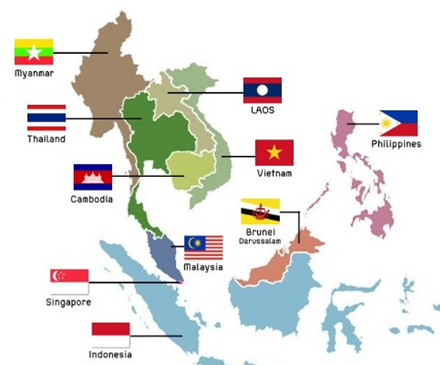Changing geopolitical dynamics in East Asia provide both challenges and opportunities for India. The recent visit of India’s prime minister to ASEAN and East Asia summits indicates growing India’s importance in the region. As global conflicts intensifies and threats for stability increase, India’s “act East policy “is becoming increasingly significant for both regional and global stability.
Relevance: GS2 (International relations).
Practice question: Discuss the significance of India’s “Act East” policy in the evolving geopolitical landscape of Southeast Asia. How does India’s role in ASEAN and its economic and security
strategies impact regional stability and global power dynamics? (250 words)

Global and Regional Challenges :
- In 1990s, ASEAN thrived due to globalisation and economic cooperation with global powers. India, through its look-east policy in 1994, re-established ties with Southeast Asia.
- US-China rivalry is defining regional geopolitics now. ASEAN, which benefitted from their cooperation, is now forced to take sides between two powers.
- China’s increased aggression in the South China Sea has increased tensions in the region. ASEAN nations are face challenges balancing economic ties with China against growing security concerns in the region.
Example: Scarborough Shoal Stand-off (2012) between China and the Philippines
- ASEAN nations remain hesitant to fully align with the US Indo-Pacific strategy due to dependency on supply chain and economic relationships with China.
For example, ASEAN-China trade reached $1.1 trillion in 2024.
- Increasing disunity among ASEAN countries is a concern;
Ex: the Myanmar crisis since 2021 has become a major source of division among ASEAN nations.
Rising India’s prominence
- Under Prime Minister Modi’s Act East Policy 2014, India has shifted from passive observer to active participant in the region.
For example, the India-Myanmar-Thailand Trilateral Highway Project.
- India’s membership in the Quad (with the US, Japan, and Australia) has strengthened its position in the Indo-Pacific region.
- India’s stance against China’s territorial expansion in the South China Sea and India’s emphasis on international law like UNCLOS reflect India’s concern for regional stability.
- India has increased its military cooperation with Southeast Asian nations.
For example, by providing BrahMos missile systems to the Philippines in 2022.
- India-ASEAN trade has doubled over the last decade, reaching $131 billion in 2023, but India faces a $38.5 billion trade deficit with ASEAN.
Economic challenges and opportunities
- India’s protectionist stance: India’s withdrawal from RCEP in 2019 over concerns about China’s dominance highlights its protectionist stance.
- India’s trade integration with Asia may face obstacles like regulatory challenges and inward-looking trade policies.
- There is ample scope for collaboration in sectors like digital trade, fintech, and renewable energy where ASAN is technologically advanced.
Conclusion
India should balance its economic and security interests in the region. Including addressing the rising trade deficit with ASEAN and the need for better economic and security strategies. Addressing these issues along with India’s Act East policy can shape the future of the Indo-Pacific region.




